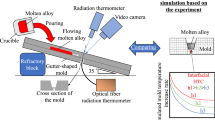Abstract
The air gap formation process at the casting/mold interface of a hollow cylinder casting was investigated for alloys solidifying in a mushy type by measuring the displacements of the casting and the mold surfaces during solidification. The formation process of the air gap between the convex casting surface and the outer mold and the heat-transfer coefficient through the gap have been well documented by previous publications. However, the air gap between the concave casting surface and the inner mold, or the core, was found to form differently during mushy solidification, in which the air gap formed during solidification, reached a maximum gap distance, and then decreased due to the contraction of the solidified casting on the expanding inner mold. The gap formation was caused by an inward collapse of the coherent dendrite networks at the concave interface because of low pressure inside of the casting due to solidification shrinkage. The coherent dendrite networks at the convex interface did not collapse inward. The heat-transfer coefficients estimated by measuring the air gap thickness showed a similar tendency to the calculated values obtained by the inverse heat-conduction analysis.
Similar content being viewed by others
References
L.S. Fletcher: ASME, J. Heat Transfer, 1988, vol. 110, pp. 1059–70.
Y. Nishida, W. Droste, and S. Engler: Metall. Trans. B, 1986, vol. 17B, pp. 833–44.
K. Ho and R.D. Pehlke: Metall. Trans. B, 1985, vol. 16B, pp. 585–94.
A. Jeyarajan and R.D. Pehlke: AFS Trans., 1976, vol. 143, pp. 647–52.
T.S.P. Kumar and K.N. Prabhu: Metall. Trans. B, 1991, vol. 22B, pp. 717–27.
S. Engler: Aluminium, 1970, vol. 46, pp. 121–26.
E.A. Brandes: Smithells Metals Reference Book, 6th ed., Butterworth and Co., London, 1983.
Metals Handbook, Properties and Selection: Nonferrous Alloys and Pure Metals, 9th ed., Asm, Metals Park, OH, 1979.
J.V. Beck: Int. J. Heat Mass Transfer, 1970, vol. 13, pp. 703–16.
J.V. Beck, B. Blackwell, and C.R. St. Clair: Inverse Heat Conduction: Ill-Posed Problems, John Wiley & Sons, New York, NY, 1985.
Z.H. Lee and T.G. Kim: Int. J. Heat Mass Transfer, 1997, vol. 40, pp. 3513–25.
M.C. Flemings: Solidification Processing, McGraw-Hill, New York, NY, 1974.
M. Bellet, F. Decultieux, M. Menai, F. Bay, C. Levaillant, J.-L. Chenot, P. Schmidt, and I.L. Svensson: Metall. Mater. Trans. B, 1996, vol. 27B, pp. 81–99.
G. Chai, L. Backerud, T. Rolland, and L. Arnberg: Metall. Mater. Trans. A, 1995, vol. 26A, pp. 965–70.
A.K. Dahle and L. Arnberg: JOM, 1996, Mar., pp. 34–37.
Author information
Authors and Affiliations
Rights and permissions
About this article
Cite this article
Lee, ZH., Kim, TG. & Choi, YS. The movement of the concave casting surface during mushy-type solidification and its effect on the heat-transfer coefficient. Metall Mater Trans B 29, 1051–1056 (1998). https://doi.org/10.1007/s11663-998-0074-2
Received:
Issue Date:
DOI: https://doi.org/10.1007/s11663-998-0074-2



